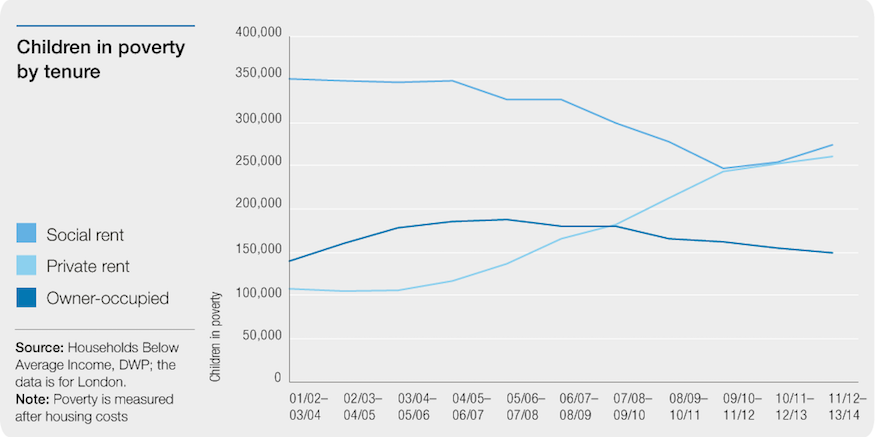
Why Generation Rent Is Worst For Children
A report today by new Policy Institute showed 27% of Londoners live in poverty — with low wages and high rents to blame. A key change in the past decade is the number of children living in the private rented sector who are in poverty. One of the report’s authors, Hannah Aldridge, explains why we should rethink what ‘generation rent’ really means.
Generation rent has become one of those terms that exemplify the life of a typical Londoner. Young working adults, living in a flat-share, paying what feels like an extortionate amount in rent because there are no alternatives, especially not buying.
But it might be time to revise this idea. A report published today highlights that the growth in the private renting in London is not confined to young adults — almost half a million children in London now live in housing rented from a private landlord — up from 180,000 a decade ago. The graph below from London’s Poverty Profile reveals why this trend is so worrying:
The total number of children in poverty in London has slightly risen in the last decade (from 600,000 to 680,000, largely to do with London’s population growth). But when this is broken down by tenure, the change has been dramatic: the number of children living in social rented housing has fallen from 350,000 to 270,000 while the number living in private rented housing has risen from 110,000 to 260,000. 10 years ago most children in poverty lived in social housing but now there are as many children in poverty living in private rented housing as social housing.
Having children in the private rented sector is a serious issue. We know it’s expensive (the average rent in London is more than double the average for England). But with adult-sharers and families vying for the same properties, it’s children that lose out. For example, a young professional couple can afford to pay a lot more to rent a one bedroom flat than a lone parent working part-time can for two bedrooms. With greater housing needs but lower incomes, parents in the private rented sector have to compromise on quality or discretionary spending to find somewhere for their children to live in London. Although this might be manageable day-to-day, there is little prospect of building up savings and qualifying for a mortgage. So housing costs are likely to remain high for the long-term and the prospect of stability or prosperity for those children already in poverty is limited.
Having children in the private rented sector is a serious issue. We know it’s expensive (the average rent in London is more than double the average for England). But with adult-sharers and families vying for the same properties, it’s children that lose out. For example, a young professional couple can afford to pay a lot more to rent a one bedroom flat than a lone parent working part-time can for two bedrooms. With greater housing needs but lower incomes, parents in the private rented sector have to compromise on quality or discretionary spending to find somewhere for their children to live in London. Although this might be manageable day-to-day, there is little prospect of building up savings and qualifying for a mortgage. So housing costs are likely to remain high for the long-term and the prospect of stability or prosperity for those children already in poverty is limited.
There are other reasons why the private rented sector is unsuitable for low income families with children. Tenancies are often short-term: over half of private renting households have lived in their home for less than two years, while the average social renter has lived in their home for over 10 years. So it is difficult for parents to anticipate where they will be living and how much it will cost more than 12 months ahead. For school-age children such moves will be disruptive. Private rented homes are also much more likely to not meet the basic decency standards — 30% of private rented homes are non-decent, double the rate of social rented homes.
So next time you find yourself bemoaning house prices or rents in London, spare a thought for the real generation rent. These 260,000 children growing up in private rented poverty are at the sharp end of London’s housing crisis — living in expensive, often low quality homes, without long-term security. ‘Affordable’ starter homes at £450,000 won’t help them.
Hannah Aldridge is an author of London’s Poverty Profile 2015 an independent report on poverty in London using official government data sources. It is written by New Policy Institute and funded by Trust for London. The report, its graphs and supporting data is available to download from: www.londonspovertyprofile.org.uk


If you have any comments, please email the author of this article and click on the link above